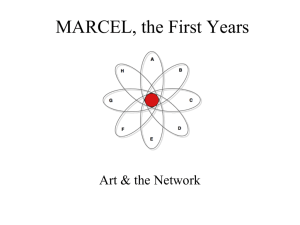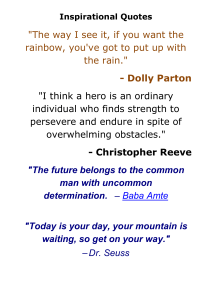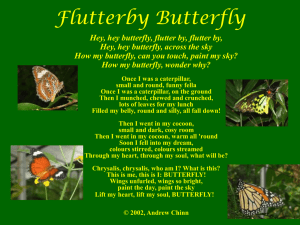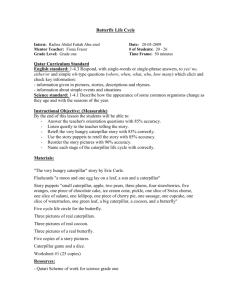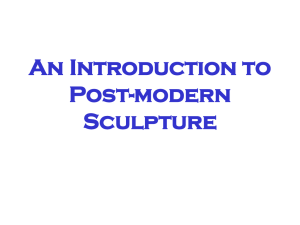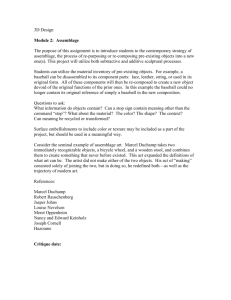K Unit 3 Week 4 Farfallina and Marcel ELLlesson
advertisement
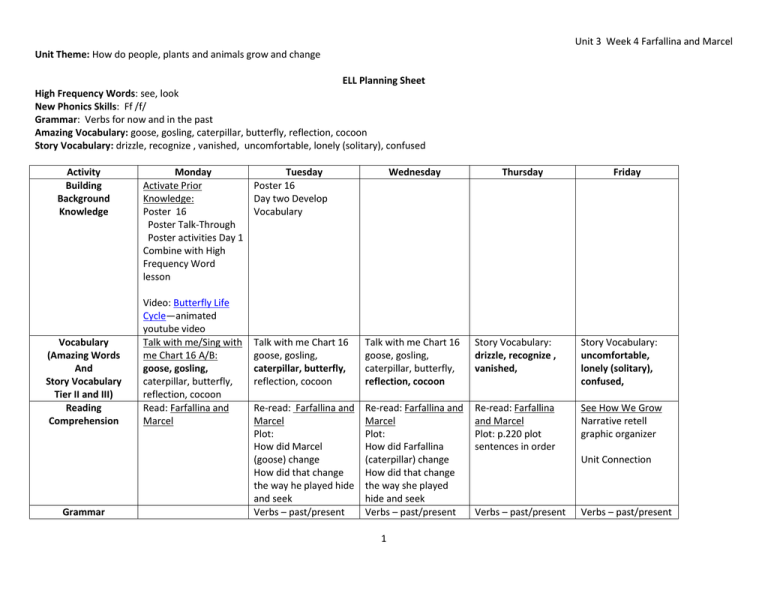
Unit 3 Week 4 Farfallina and Marcel Unit Theme: How do people, plants and animals grow and change ELL Planning Sheet High Frequency Words: see, look New Phonics Skills: Ff /f/ Grammar: Verbs for now and in the past Amazing Vocabulary: goose, gosling, caterpillar, butterfly, reflection, cocoon Story Vocabulary: drizzle, recognize , vanished, uncomfortable, lonely (solitary), confused Activity Building Background Knowledge Vocabulary (Amazing Words And Story Vocabulary Tier II and III) Reading Comprehension Grammar Monday Tuesday Activate Prior Poster 16 Knowledge: Day two Develop Poster 16 Vocabulary Poster Talk-Through Poster activities Day 1 Combine with High Frequency Word lesson Video: Butterfly Life Cycle—animated youtube video Talk with me/Sing with me Chart 16 A/B: goose, gosling, caterpillar, butterfly, reflection, cocoon Read: Farfallina and Marcel Wednesday Thursday Friday Talk with me Chart 16 goose, gosling, caterpillar, butterfly, reflection, cocoon Talk with me Chart 16 goose, gosling, caterpillar, butterfly, reflection, cocoon Story Vocabulary: drizzle, recognize , vanished, Story Vocabulary: uncomfortable, lonely (solitary), confused, Re-read: Farfallina and Marcel Plot: How did Marcel (goose) change How did that change the way he played hide and seek Verbs – past/present Re-read: Farfallina and Marcel Plot: How did Farfallina (caterpillar) change How did that change the way she played hide and seek Verbs – past/present Re-read: Farfallina and Marcel Plot: p.220 plot sentences in order See How We Grow Narrative retell graphic organizer 1 Unit Connection Verbs – past/present Verbs – past/present Unit 3 Week 4 Farfallina and Marcel Unit Theme: How do people, plants and animals grow and change Writing High Frequency Words Spelling (Phonics) Readers Look, see (combine with Build Background Knowledge lesson) Poster 16 day 1 Flash Cards Ff /f/ (DI 48 / DI30) Phonemic Awareness (pictures) segment (fan, fit, fun) Pg 205 Speak Teacher model Look, see Spell sentences Find HF words in Phonics Reader: For Me! Flash Cards Ff /f/ Phonics Discriminate initial sound fence, gate, fan, door, feather, bird Blend (fan, fox, can) Phonic Reader: For Me! (keep to re-read on Day 3) Pg 218 Students id when sentence happened Look, see Poster 16 Day 3 Speaking Practice – sentences Flash Cards Pg 245 Students change sentence Look, see Flash Cards Find HF words in Decodable Reader: In The Kit! Practice Book pg 40 Ff /f/ Phonics Discriminate last sound (+/+ blend (fit, Kit, fan) Ff /f/ Phonics - spelling (mop, top, not, cot, pot, tap) Ff /f/ Phonics- spelling (tip, dip, dot, cat, pat, sad) Re-read Phonics Reader: For Me! Decodable Reader: In The Kit! (keep to re-read on Day 5) Decodable Reader In The Kit! Unit 1 Proposed Assessment Plan Measure High frequency words Frequency weekly Assessor Classroom teacher Verbal retell weekly Classroom teacher 2 Look, see Flash Cards Unit 3 Week 4 Farfallina and Marcel Unit Theme: How do people, plants and animals grow and change Writing CBM biweekly ELL tutor 3 Unit 3 Week 4 Farfallina and Marcel Unit Theme: How do people, plants and animals grow and change Day 1 High Frequency Words: see, look New Phonics Skills: Ff /f/ Grammar: Verbs for now and in the past Amazing Vocabulary: goose, gosling, caterpillar, butterfly, reflection, cocoon Story Vocabulary: drizzle, recognize , vanished, uncomfortable, lonely (solitary), confused Background Knowledge Vocabulary (Amazing Words and Story Vocabulary Tier II and III) Poster 16 Poster Talk-through – read aloud and point as you describe the poster. Have students repeat the underlined words in the script, after you say them and identify on the poster. Students need to respond to the following questions with one of the embedded answer choices or complete sentence as modeled. Error Corrections: If needed, model, test, and ask the same question at the end of this section to retest. o What are the frogs doing? The frogs are playing a leap frog game. o Are the frogs in the water or the grass? The frogs are in the grass. o What are the tadpoles doing? The tadpoles are playing a chasing game. o Are the tadpole is the water or the grass? The tadpoles are in the water? o Could the tadpoles, play leapfrog with the frogs? No o What do tadpoles need to play leap frog, wings or legs? Tadpoles need legs to play leap frog. o Will the tadpoles change into frogs or dragon fly? The tadpoles will change into frogs. o Are these animals in the woods or the pond? These animals are in the pond. Video: Butterfly Life Cycle—animated youtube video Display Talk with Me Chart 16 A “This week we will be talking about friends and how friendships change.” This is a picture of a goose. o What does a goose. look like? A goose looks like _____., or A goose has_____. o Is a goose a large or small bird? A goose is a large bird. o What is this goose swimming in? The goose is swimming in water. o A goose is a large bird that makes its home near water. o What is a goose? A large bird that makes its home near water. o What do we call a large bird that makes its home near water? A goose This is what a goose looks like when it is a baby. o A baby goose is called a gosling. o What is a gosling? A baby goose o What do we call a baby goose? A gosling o What does a gosling look like? A gosling looks like _____., or A gosling has_____. This is a caterpillar. o A caterpillar is an insect that makes a cocoon. o What is a caterpillar? An insect that makes a cocoon o What do we call an insect that makes a cocoon? A caterpillar This is a butterfly . 4 Unit 3 Week 4 Farfallina and Marcel Unit Theme: How do people, plants and animals grow and change o A butterfly is a flying insect with colorful wings. o What is a butterfly? A flying insect with colorful wings o What do we call a flying insect with colorful wings? A butterfly Display and read pg 15 of Farfallina and Marcel o A reflection is what we see when we look in a mirror. o Where can you see your reflection. I see my reflection in a mirror. o What is it called when you see yourself in the mirror? A reflection Do you remember what a caterpillar makes? A cocoon o A cocoon is a shell where a caterpillar turns into a butterfly. o What is a cocoon? A shell where a caterpillar turns into a butterfly. o What do we call a shell where a caterpillar turns into a butterfly? A cocoon Reading Display Farfallina nd Marcel. Comprehension Look at the cover. Think Aloud: I see a gosling and a caterpillar. They look like they are friends. The title of this book is Farfallina nd Marcel.. What do you think this story will be about? Read Farfallina nd Marcel. Grammar and Writing High Frequency Look, see Words Poster 16 day 1 develop Concepts and Vocabulary Look at the animals in the pond. How many ducks do you see? I see four ducks when I look. Look at the animals in the pond. How many tadpoles do you see? I see four tad poles when I look. Look at the animals in the pond. How many lily pads do you see? I see six lily pads when I look. Look at the animals in the pond. How many frogs on the lily pads do you see? I see two frogs on the lily pads when I look. Look at the animals in the grass. How many frogs do you see? I see three frogs when I look. Spelling (Phonemic Awareness/ Phonics) Here are this week’s high frequency words. This word is look. What word? look This word is see. What word? see Second Time When I touch under the word, say the word in your head. When I tap under the word, everyone will say the word aloud. Practice the word list until they read the list without errors. Unpredictable individual turns (Not everyone will have an individual turn.) Ff /f/ Today we will learn a new sound. Listen and watch as I say the sound: /f/, /f/, /f/. o Please say the /f/ sound……/f/ /f/ /f/ o Say Four fish fell fast. …. Four fish fell fast. Have students feel the air on their hands as they say the words. 5 Unit 3 Week 4 Farfallina and Marcel Unit Theme: How do people, plants and animals grow and change o What sound do four fish fell fast start with? /f/ Show the fan and nut pictures. o Have students say the words with you as you point to the pictures. o Which word starts with /f/? Fan or nut? Fan o Repeat with the following picture pairs: flag/map, feather/ sun, frog/house Use three fingers to help children see the number of sounds you say while segmenting a word. Model then have students repeat. o Segment the word fan. Hold up fingers as you say the individual sounds. “fan: f - a - n” o Say it with me. fan: f - a - n o You do it. fan: f - a - n o Repeat with the following words: fit, fun Readers 6 Unit 3 Week 4 Farfallina and Marcel Unit Theme: How do people, plants and animals grow and change 7 Unit 3 Week 4 Farfallina and Marcel Unit Theme: How do people, plants and animals grow and change Day 2 High Frequency Words: see, look New Phonics Skills: Ff /f/ Grammar: Verbs for now and in the past Amazing Vocabulary: goose, gosling, caterpillar, butterfly, reflection, cocoon Story Vocabulary: drizzle, recognize , vanished, uncomfortable, lonely (solitary), confused Background Knowledge Vocabulary (Amazing Words and Story Vocabulary Tier II and III) Poster 15 Day 2 Follow directions on poster for activity: Then Now Display Talk with Me Chart 16 A “This week we will be talking about friends and how friendships change.” This is a picture of a goose. o A goose is a large bird that makes its home near water. o What is a goose? A large bird that makes its home near water. o What do we call a large bird that makes its home near water? A goose This is what a goose looks like when it is a baby. o A baby goose is called a gosling. o What is a gosling? A baby goose o What do we call a baby goose? A gosling This is a caterpillar. o What does a caterpillar look like? (one of the descriptions needs to be that it looks like a worm – with legs) o Do you think a caterpillar is an insect or a fish? A caterpillar is an insect o Point to the cocoon. The caterpillar made this cocoon. What makes a cocoon? A caterpillar makes a cocoon. o A caterpillar is an insect that makes a cocoon. o What is a caterpillar? An insect that makes a cocoon o What do we call an insect that makes a cocoon? A caterpillar This is a butterfly . o What does a butterfly look like? o A caterpillar turns into a butterfly. o What does a caterpillar turn into? A butterfly o A butterfly is a flying insect with colorful wings. o What is a butterfly? A flying insect with colorful wings o What do we call a flying insect with colorful wings? A butterfly Display and read pg 15 of Farfallina and Marcel o A reflection is what we see when we look in a mirror. o Where can you see your reflection. I see my reflection in a mirror. o What is it called when you see yourself in the mirror? A reflection Do you remember what a caterpillar makes? A cocoon o A cocoon is a shell where a caterpillar turns into a butterfly. o What is a cocoon? A shell where a caterpillar turns into a butterfly. o What do we call a shell where a caterpillar turns into a butterfly? A cocoon Reading Display Farfallina And Marcel, and Venn Diagram Comprehension We are going to use the Venn Diagram to show how Marcel the gosling is the same and different then Marcel the goose. Do a picture walk to help students 8 Unit 3 Week 4 Farfallina and Marcel Unit Theme: How do people, plants and animals grow and change Grammar and Writing High Frequency Words compare and contrast. o Gosling: little voice, small, grey, soft feathers o Goose: fly, bigger, brown and black colors, sleek feathers o Both: gentle eyes, swim, friend with Farfallina When Marcel was a gosling how did he hide for Farfallina? Marcel hid close by because Farfallina moved slow. When Marcel was a goose, how did he hide for Farfallina? Marcel did not fly to fast, because Farfallina could not fly fast. Re-read See How We Grow Verb For Now and the Past Words that tell what we are doing are verbs. o What are verbs? Words that tell what we are doing o What do we call a word that tells what we are doing? A verb o Sometimes we use a verb to tell what someone is doing now, and sometimes we use a verb to tell what someone has done in the past. Today, I teach the class. (Point down to represent present) Yesterday, I taught the class. (Use thumbs to point over and behind your shoulder to represent past.) I am teaching in both sentences. But we use different words for things we do now and things we do in the past Modeling/Practice o Say (and point down to represent present): Marcel swims in the pond. That is happening now. o Say it with me (and have students point down to represent present): Marcel swims in the pond. o Now I am going to change the word swims and make it happen in the past (Use thumbs to point over and behind your shoulder to represent past.) o Say (and use thumb to point over and behind your shoulder to represent past.) Marcel swam in the pond. o Say it with me (and have students use thumb to point over and behind your shoulder to represent past.) Marcel swam in the pond. Repeat above script using the following sentence pairs: o Farfallina hides under a leaf. / Farfallina hid under a leaf. o It rains in the morning. / It rained in the morning. o I go to school. / I went to school. Look, see This word is see. What word? see Everyone, spell see. s-e-e What word did you spell? See A sentence with the word see is….”I see Marcel swimming in the pond.” Ask students to use see in a sentence. This word is look. What word? look Everyone spell look. L-o-o-k What word did you spell? Look A sentence with the word look is….”Look Farfallina is now a beautiful butterfly.” 9 Unit 3 Week 4 Farfallina and Marcel Unit Theme: How do people, plants and animals grow and change Ask students to use look in a sentence. Second Time When I touch under the word, say the word in your head. When I tap under the word, everyone will say the word aloud. Practice the word list until they read the list without errors. Unpredictable individual turns (Not everyone will have an individual turn.) Spelling (Phonics) Have students mark the words: look, see in the Phonics reader For Me! Ff /f/ Hold up an F letter card. This is the letter F. It makes the /f/ sound. o Give each student an F letter card. o Trace the letter F on your card and say /f/. o What sound does this letter make? /f/ o What is the name of this letter? F I am going to say some words. If the word starts with the /f/ sound, hold up the letter F card. o fence, gate, fan, door, feather, bird Use the page with arrows and blocks to practice blending words together. Readers Use the page with arrows and blocks to practice blending words together. o With students slowly sound out each letter while pointing to the letter with finger. o With students repeat sounding out and pointing at a faster speed. o With students repeat reading and pointing at a normal speed. Phonics Reader : For Me Keep reader to re-read on Day 3 10 Unit 3 Week 4 Farfallina and Marcel Unit Theme: How do people, plants and animals grow and change GOSLING GOOSE BOTH 11 Unit 3 Week 4 Farfallina and Marcel Unit Theme: How do people, plants and animals grow and change F F F F 12 Unit 3 Week 4 Farfallina and Marcel Unit Theme: How do people, plants and animals grow and change f a n f o x c a n 13 Unit 3 Week 4 Farfallina and Marcel Unit Theme: How do people, plants and animals grow and change Day 3 High Frequency Words: see, look New Phonics Skills: Ff /f/ Grammar: Verbs for now and in the past Amazing Vocabulary: goose, gosling, caterpillar, butterfly, reflection, cocoon Story Vocabulary: drizzle, recognize , vanished, uncomfortable, lonely (solitary), confused Vocabulary Display Talk with Me Chart 16 A (Amazing “This week we will be talking about friends and how friendships change.” Words This is a picture of a goose. and o A goose is a large bird that makes its home near water. Story o What is a goose? A large bird that makes its home near water. Vocabulary o What do we call a large bird that makes its home near water? A goose Tier II and III) This is what a goose looks like when it is a baby. o A baby goose is called a gosling. o What is a gosling? A baby goose o What do we call a baby goose? A gosling This is a caterpillar. o A caterpillar is an insect that makes a cocoon. o What is a caterpillar? An insect that makes a cocoon o What do we call an insect that makes a cocoon? A caterpillar This is a butterfly . o A butterfly is a flying insect with colorful wings. o What is a butterfly? A flying insect with colorful wings o What do we call a flying insect with colorful wings? A butterfly Display and read pg 15 of Farfallina and Marcel o When Marcel looked in the pond, he could see himself. o When Marcel looked in the pond, he could see his reflection. o Does this goose on the poster have a reflection? Yes, the goose has a reflection o What do you look into to see your reflection? I look into a mirror to see my reflection. o A reflection is what we see when we look in a mirror. o Where can you see your reflection. I see my reflection in a mirror. o What is it called when you see yourself in the mirror? A reflection Do you remember what a caterpillar makes? A cocoon o A caterpillar makes a cocoon . o The caterpillar wraps or spins the cocoon all around its body. o What is wrapped up inside the cocoon? A caterpillar o A cocoon is like a shell. The cocoon will get hard. o Why do you think the cocoon turns into a hard shell? The cocoon turns into a hard shell to protect the caterpillar inside. o When the caterpillar is inside the cocoon. It turns into a butterfly. o Where does the caterpillar change into a butterfly? The caterpillar changes into a butterfly in the cocoon. o A cocoon is a shell where a caterpillar turns into a butterfly. o What is a cocoon? A shell where a caterpillar turns into a butterfly. o What do we call a shell where a caterpillar turns into a butterfly? A cocoon 14 Unit 3 Week 4 Farfallina and Marcel Unit Theme: How do people, plants and animals grow and change Reading Display Farfallina And Marcel, and Sequence Graphic Organizer Comprehension We are going to use this graphic Organizer to help us write down the order that Farfallina changes into a butterfly. Do a picture walk and have students tell you the sequence of events for a caterpillar to change into a butterfly. o Pg 5: First - Farfallina is a caterpillar o Pg. 17: Second – Farfallina forms a cocoon and hangs from a leaf all winter o Pg 18: Third – The cocoon breaks open. o Pg 19: Fourth – Farfallina comes out of the cocoon and opens her wings o Pg 22: - Fifth – Farfallina can fly. When Farfallina was a caterpillar how did she hide for Marcel? Farfallina hid low because Marcel could not climb. When Farfallina was a butterfly, how did she hide for Marcel? Farfallina did not hide on the colorful flowers, because Marcel would not see her. Re-read Farfallina and Marcel Grammar and Verb For Now and the Past Writing Words that tell what we are doing are verbs. o What are verbs? Words that tell what we are doing o What do we call a word that tells what we are doing? A verb o Sometimes we use a verb to tell what someone is doing now, and sometimes we use a verb to tell what someone has done in the past. Today, I teach the class. (Point down to represent present) Yesterday, I taught the class. (Use thumbs to point over and behind your shoulder to represent past.) I am teaching in both sentences. But we use different words for things we do now and things we do in the past o I am going to say a sentence. You show me if the verb happens now (point down to represent present), or in the past (use thumb to point over and behind shoulder to represent past). I read a book. I am writing my name. My dog barked at the mail carrier The children sang a song I am jumping on the trampoline. The mouse hides from the cat. We clapped when the show was over. High Frequency Look, see Words Display Poster 16 Model saying “Look (point/hold up the look card). I see (point/hold up the see card) a duck.” Point to the words and say it with me…..“Look (point/hold up the look card). I see (point/hold up the see card) a duck.” Without me, point to the words and say it …..“Look (point/hold up the look card). I see (point/hold up the see card) a duck.” Repeat letting each student have a turn to create a sentence. Everyone repeat and point to words. 15 Unit 3 Week 4 Farfallina and Marcel Unit Theme: How do people, plants and animals grow and change Spelling (Phonics) Readers Second Time When I touch under the word, say the word in your head. When I tap under the word, everyone will say the word aloud. Practice the word list until they read the list without errors. Unpredictable individual turns (Not everyone will have an individual turn.) Ff /f/ Hold up an F letter card. This is the letter F. It makes the /f/ sound. o Give each student a F letter card. o Trace the letter F on your card and say /f/. o What sound does this letter make? /f/ o What is the name of this letter? F I am going to say some words. If the last sound in the word is /f/, hold up the F letter card. o Teacher say: leaf o Say it with me: leaf o What is the last sound in the word leaf? /f/ o Repeat script using the following words: leaf, acorn, loaf, bread, wolf, howl Use the page with arrows and blocks to practice blending words together. o With students slowly sound out each letter while pointing to the letter with finger. o With students repeat sounding out and pointing at a faster speed. o With students repeat reading and pointing at a normal speed. Re-read Phonics Reader : For Me! 16 Unit 3 Week 4 Farfallina and Marcel Unit Theme: How do people, plants and animals grow and change f i t K i t f a n 17 Unit 3 Week 4 Farfallina and Marcel Unit Theme: How do people, plants and animals grow and change Day 4 High Frequency Words: see, look New Phonics Skills: Ff /f/ Grammar: Verbs for now and in the past Amazing Vocabulary: goose, gosling, caterpillar, butterfly, reflection, cocoon Story Vocabulary: drizzle, recognize , vanished, uncomfortable, lonely (solitary), confused Vocabulary (Amazing Words and Story Vocabulary Tier II and III) Story Vocabulary: drizzle, recognize , vanished ““This week we will be talking about friends and how friendships change.” Display and read pg 8 of Farfallina and Marcel o A drizzle is a light rain. o What is a drizzle? A light rain o What do we call a light rain? A drizzle o When the rain turned to drizzle, or a light rain, Farfallina wanted to play. o Say it with me…. When the rain turned to drizzle, or a light rain, Farfallina wanted to play. Say recognize. … recognize o Recognize means to know something you have seen before. o Display pg 15 of Farfallina and Marcel. o Marcel had changed. When he looked at his reflection in the water he almost did know that is was him o Marcel did not recognize himself. o Why did Marcel not know he was seeing himself in the water? Because he had changed and looked different o Sometimes when we don’t see someone for a long time they change and look different. o We might not recognize them the next time we see them. o Has this happened to you? o Recognize means to know something you have seen before. o What does recognize mean? to know something you have seen before. o What do we call it when you know something you have seen before? Recognize o Did Farfallina recognize Marcel when she came back to the lake? No o Did Marcel recognize Farfallina at the lake? no Display and read pg 24 of Farfallina and Marcel o To vanish into thin air means someone is gone, and you don’t know what happened to them. o Farfallina vanished into thin air. Marcel did not know where Farfallina had gone, and what had happened to her. o To vanish into thin air means someone is gone, and you don’t know what happened to them. o What does vanish into thin air mean? Someone is gone and you don’t know what happened to them o What do we say when someone is gone and we don’t know what happened to them? Vanished into thin air Reading Display Farfallina and Marcel Comprehension All stories have a beginning, a middle and an end. We call the things that happen in the beginning, middle and end of a story the plot. 18 Unit 3 Week 4 Farfallina and Marcel Unit Theme: How do people, plants and animals grow and change Grammar and Writing High Frequency Words o What is the plot of a story? The beginning, middle, and end of the story o What do we call the beginning, middle and end of the story? plot Present the three sentences (cut into strips and out of order). I will read these to you and you tell me what order to put them in. o Farfallina and Marcel meet each other and become friends. o The two friends change and don’t recognize each other when they meet again. o Farfallina and Marcel figure out who the other one is and discover they are still good friends. Which sentence happened at the beginning? Which sentence happened in the middle? Which sentence happened at the end? Re-read Farfallina and Marcel Verb For Now and the Past Words that tell what we are doing are verbs. o What are verbs? Words that tell what we are doing o What do we call a word that tells what we are doing? A verb o Sometimes we use a verb to tell what someone is doing now, and sometimes we use a verb to tell what someone has done in the past. Today, I teach the class. (Point down to represent present) Yesterday, I taught the class. (Use thumbs to point over and behind your shoulder to represent past.) I am teaching in both sentences. But we use different words for things we do now and things we do in the past Invite a student to complete the sentence I ________. while they act out the verb. o Everyone repeat the sentence while they act out the verb. o Ask another student to change the sentence to something that happened in the past, (while pointing thumb over and behind shoulder to represent something that happened in the past). Example I jumped. ( no jumping action) o Everyone repeat the past tense sentence while pointing thumb over shoulder. o Allow several students a turn to select present tense sentence. Look, see First Time When I touch under the word, say the word in your head. When I tap under the word, everyone will say the word aloud. Practice the word list until they read the list without errors. Unpredictable individual turns (Not everyone will have an individual turn.) Second Time Pass out Decodable Reader -The Kit! Have students find and underline the sight words look, see in the story. Spelling (Phonics) Ff /f/ Display an F letter card. This is the letter F. It makes the /f/ sound. 19 Unit 3 Week 4 Farfallina and Marcel Unit Theme: How do people, plants and animals grow and change What is the name of this letter? F What sound does this letter make? /f/ Have students air write the letter F while saying the /f/ sound. Readers We are going to spell some words. Pass out writing materials. If a word is a proper noun, remind students to begin that word with a capital letter. Teacher say “mop” Students say “mop” Teacher and students segment word. Hold up one finger for each letter sound. m - o - p Students write the word. Repeat for the following words: top, not, cot, pot, tap Decodable Reader: The Kit! Keep reader to re-read on Day 5 20 Unit 3 Week 4 Farfallina and Marcel Unit Theme: How do people, plants and animals grow and change Farfallina and Marcel meet each other and become friends. The two friends change and don’t recognize each other when they meet again. Farfallina and Marcel figure out who the other one is and discover they are still good friends. 21 Unit 3 Week 4 Farfallina and Marcel Unit Theme: How do people, plants and animals grow and change Day 5 High Frequency Words: see, look New Phonics Skills: Ff /f/ Grammar: Verbs for now and in the past Amazing Vocabulary: goose, gosling, caterpillar, butterfly, reflection, cocoon Story Vocabulary: drizzle, recognize , vanished, uncomfortable, lonely (solitary), confused Vocabulary Story Vocabulary: uncomfortable, lonely (solitary), confused (Amazing ““This week we will be talking about friends and how friendships change.” Words Display pg 12. Farfallina did not want to play anymore because she felt and uncomfortable. Story o If you sit on a hard chair for a really long time you will feel Vocabulary uncomfortable. Tier II and III) o Let’s see how long we can hold our arms up…..After a while help students recognize and express that their arms are uncomfortable. o Uncomfortable means something hurts, or doesn’t feel good. o What does uncomfortable mean? something doesn’t feel good or hurts. o What do we call it when something doesn’t feel good or it hurts? Uncomfortable o What did Farfallina do when she felt uncomfortable? She went to rest Display and read page 14. How did Marcel feel when Farfallina didn’t come down? Marcel felt lonely. o Lonely is when you feel like you are all by yourself. o Did Marcel like feeling lonely? No o Display and read pg 21. o Is anyone making circles with Marcel? o Marcel is making circle all by himself. No one is with him. He is lonely. o Marcel was swimming in solitary circles. o Solitary means you are the only one. You are by yourself. o Marcel is swimming in circles by himself. o When you are solitary, or the only one, you might feel lonely. Display and read pg 20. Farfallina was confused. o Farfallina did understand why Marcel was not there. o Confused is when you don’t understand. o What does confused mean? you don’t understand o What is the word for when you don’t understand something? confused Reading Display Farfallina and Marcel. Comprehension Display the narative retell graphic organizer. We are going to use this graphic organizer to retell the story. Prompt students to tell the sequence of the story. Use book as a reference. Write student responses in the graphic organizer We have talked about a lot of different animals that grow and change. Can you tell me some of the animals we have read about? Panda, little quack, Samantha and Serena, Farfallina and Marcel How do Panda bears grow and change? How did Little Quack change? How did Samantha and Serena grow and change? How did Farfallina and Marcel change? 22 Unit 3 Week 4 Farfallina and Marcel Unit Theme: How do people, plants and animals grow and change Grammar and Writing High Frequency Words Spelling (Phonics) Readers Verbs Practice Book pg 40 Look, see When I touch under the word, say the word in your head. When I tap under the word, everyone will say the word aloud. Practice the word list until they read the list without errors. Unpredictable individual turns (Not everyone will have an individual turn.) Ff /f/ Display an F letter card. This is the letter F. It makes the /f/ sound. What is the name of this letter? F What sound does this letter make? /f/ Have students air write the letter F while saying the /f/ sound. We are going to spell some words. Pass out writing materials. If a word is a proper noun, remind students to begin that word with a capital letter. Teacher say “tip” Students say “tip” Teacher and students segment word. Hold up one finger for each letter sound. t - i - p Students write the word. Repeat for the following words: dip, dot, cat, pat, sad Decodable Reader : The Kit! 23
